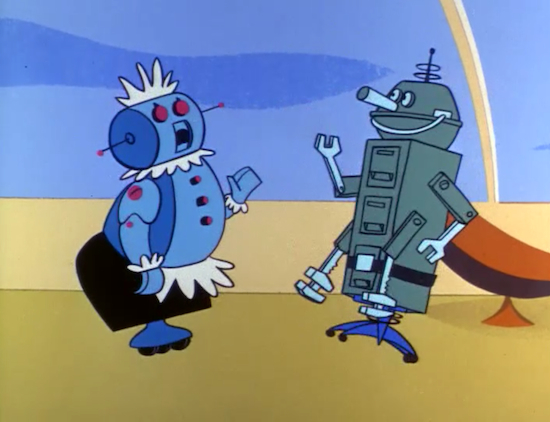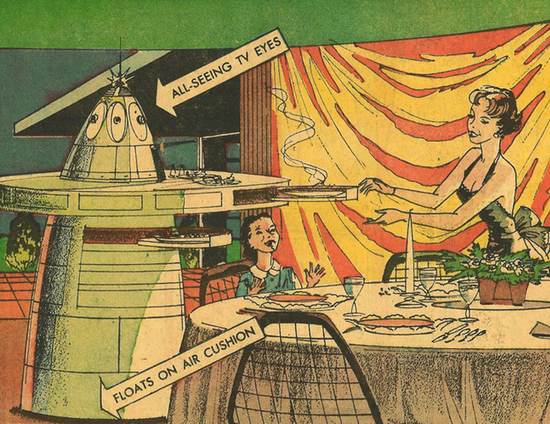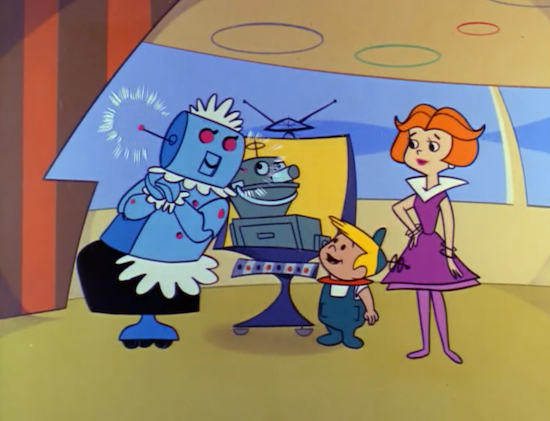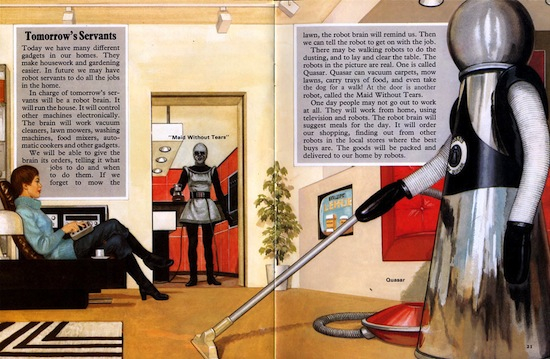Recapping ‘The Jetsons’: Episode 08 – Rosey’s Boyfriend
The personal humanoid robotic assistant easily makes the short list of retro-futuristic dreams still unfulfilled
![]()
![]()
![]()
 This is the eighth in a 24-part series looking at every episode of “The Jetsons” TV show from the original 1962-63 season.
This is the eighth in a 24-part series looking at every episode of “The Jetsons” TV show from the original 1962-63 season.
The personal humanoid robotic assistant (or robot maid; robot butler; whatever you’d like to call it) easily makes the short list of retro-futuristic dreams still unfulfilled — up there with the flying car, the jetpack and the meal-in-a-pill. Sure, some people have the Roomba — that Cheetos-hungry robo-pet that crawls around your living room floor — but the dream of the humanoid robot, the robot that can interact with the family naturally, the robot that can speak and understand commands; this is the robot we know and love from media like The Jetsons. And it’s the robot we’re still so desperately longing for.
The eighth episode of The Jetsons originally aired on American television on November 11, 1962 and was titled “Rosey’s Boyfriend.” This episode devotes a fair amount of time to Rosey, an iconic character from the series who actually doesn’t enjoy much screen time in the original 1962-63 season. We first met Rosey in the premiere episode when Jane hopes to get a state-of-the-art robot maid and is stuck with an older model without the latest bells and whistles. Rosey is a devoted household servant who, despite being an older unwanted model, has many redeeming qualities. By the end of the first episode Rosey, of course, becomes a valued member of the family.
In this episode, Rosey falls in love with Mack, a helper robot built by the apartment building superintendent Henry. Mack appears to be made out of a filing cabinet and the kind of rolling stand you might find on the bottom of an office chair. This romance parallels Judy Jetson’s own love story, wherein she’s “boy crazy” and her latest crush is all consuming. Though Rosey supposedly isn’t programmed for love, that doesn’t stop her from being an incredibly sensitive robot and falling for Mack; and for Mack to fall in love with Rosey. Sadly for Rosey, Mack gets deactivated when he begins to malfunction. Elroy re-activates Mack and lets Rosey talk to him via the visaphone in Henry’s workshop. Rosey’s robo-depression is cured — provided she gets five minutes of visaphone time with Mack each day.

Rosey and Mack from the eighth episode of the Jetsons TV show
We often turn to the Sunday comic “Closer Than We Think” (1958-63) by Arthur Radebaugh to understand the futuristic thinking of the early space age. Many of the techno-utopian ideas of that strip made their way into The Jetsons. The September 13, 1959 edition of the strip showed a robot floating on a cushion of air. It also had cameras mounted on its head — in 360-degree vision. The strip explained that industrial designers at Sundberg, Ferar Inc. were developing this “mechanical maid” of the future, a kind of self-propelled serving cart which would “move linen, glasses, china and silver to the table.” After dinner, as the strip showed, the dirty dishes would be whisked away by the robot to be cleaned and stored.

September 13, 1959 edition of the Sunday comic strip “Closer Than We Think” by Arthur Radebaugh
Coincidentally, this strip ran on the same day that the Chicago Tribune ran a column by Evelyn Zemke about the domestic work of the housewife of the year 2000. You may recall from our look at the first episode that the technologically advanced world of the future is not without its faults: the electronic brain serves the wrong breakfast and the robot vacuum cleaner goes a bit haywire. Rosey’s love interest Mack, seems to suffer from a similar case of crossed wires. These technological mishaps no doubt exist to allow the people of 1962 to identify with malfunctioning consumer appliances of the postwar era.

Rosey and Mack over the videophone
Rosey would inspire countless robots in later decades. Some “robots” like Miss Honeywell (a magician’s human assistant used to sell appliances and computers) would in the late 1960s bare a striking resemblance to Rosey, right down to her color scheme. The 1970s and ’80s would see an explosion in expectations around the household robot, including many a fraudulent company. Every new technology seems to invite hucksters–and robots of the 20th century were no different. Among the most noteworthy scam artists was New Jersey’s Quasar Industries, which made many promises in the 1970s that the household domestic robot had arrived. Klatu, the household android (sometimes known as just Quasar) wasn’t capable of even half the tasks that Quasar advertised — vacuuming, cleaning the dishes, mowing lawns and even walking the dog! But that didn’t stop the company from insisting that the future was now. In the 1978 illustrated book Exploring the World of Robots, kids learned about Quasar and Miss Honeywell (more generically known as “The Maid Without Tears):
There may be walking robots to do the dusting, and to lay and clear the table. The robots in the picture are real. One is called Quasar. Quasar can vacuum carpets, mow lawns, carry trays of food, and even take the dog for a walk! At the door is another robot, called the Maid Without Tears.
One day people may not go out to work at all. They will work from home, using television and robots. The robot brain will suggest meals for the day. It will order our shopping, finding out from other robots in the local shops where the best buys are. The goods will be packed and delivered to our home by robots.

Quasar and the “Maid Without Tears” in the 1978 book “Exploring the World of Robots”
We’re still waiting for the arrival of the Rosey and other robot butlers, but for today we may have to be content with simply feeding our Roombas.
/https://tf-cmsv2-smithsonianmag-media.s3.amazonaws.com/accounts/headshot/matt-novak-240.jpg)
/https://tf-cmsv2-smithsonianmag-media.s3.amazonaws.com/accounts/headshot/matt-novak-240.jpg)